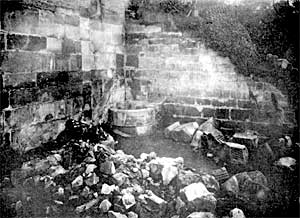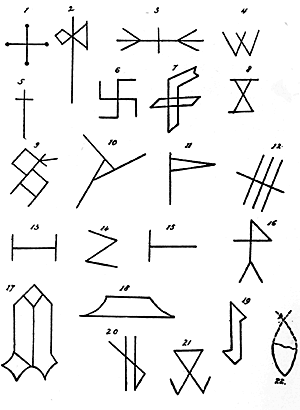
View of castle excavations, looking south-west.
In removing the rubble from this ruin, in the summer of 1908, a chute was made down to the Lenton Road, care being taken to preserve any masonry of interest. About eighteen feet below the present castle level, the rock floor of the tower was struck. It had apparently been covered with plaster as much remained about. The base of an octagonal pillar of Bulwell stone was found near the centre, and this, together with certain pieces of worked masonry showing the springing of the ribs, gave evidence of a column having supported a groined ceiling.
There was no fireplace, nor any evidence in the shape of rings in, or carving on the walls, to show that the place had been used as a dungeon. In the south-west corner of the floor a circular stone well-head,f illed up with rubble to its mouth, was uncovered. At first, the idea suggested itself, that it probably led down to some passage forming one of the old sally-ports on this western side of the rock, but after excavating to the depth of fifty feet, and bringing up rubble and huge pieces of masonry, one could come to no other conclusion than that it was a well, which in all probability went down another 130 or 140 feet. The well is beautifully cut in the rock, three feet in diameter, and has footholes on either side as far down as the excavations have gone. Smythson in his plan shows what are supposed to be the records of two wells, one in the Norman fortress, and the other in the second court. Leland says that he saw three, so this was probably the third one.
Mention has been made of the old mediaeval retaining wall which, as excavations have shown, lies underneath the present one, which was doubtless built by the second Duke of Newcastle between the years 1676 and 1680. This discovery is most interesting, as it goes to show that the present castle-green is several feet—from measurements I calculate ten to twelve—higher than the original level of the court. This may well be so, for the gigantic amount of rubble and material which belonged to the old fortress and with which the Newcastle builders had to contend, was probably got rid of by filling up this great area of the second court. It would account also for the fact, that when the present carriage road into the castle grounds was made cutting through its north and northwest side, no evidence of the old Edwardian buildings was found.
Limited excavations have been made in the rubble lying outside the tower on its south side, and pipes, pottery, leaded lights, glass, bullets, nails, and one or two iron tools have been found. These are of the 17th century, being relics of the soldiery of the civil war period, and of the builders of the Cavendish Palace. Some of the leaded lights and glass may probably belong to the 16th century, and a piece of encaustic tile to the century earlier, but there is no doubt that for long years after the destruction of the Castle, the area round this rock side would be a quarry for the inhabitants of the town, and any relics of earlier times would be unearthed and carried away. Pipe stems, stamped with the name "Wm Sefton," prove to us that the unique earthenware and oldest memorial headstone in St. Mary's churchyard, raised to the memory of the two daughters of Wm Sefton (1707 and 1714) was the work of a Nottingham potter; and in all probability this William Sefton was the originator and inventor of this type of memorial, as no earlier one has been found in England.1
The discovery of numerous masons' marks has been an interesting feature in these excavations. All these marks have been found on the walls, or on stones which formed part of the interior of the tower. Gedling stone, of which it was built, is of a somewhat soft nature, and there can be no doubt, that it is owing to these marks never having been exposed to weathering, that their survival is due. Already many of them, since they have been exposed to the open air, are wearing away, and in a few years time there will be few, if any, remaining of the marks now recorded.
A halo of mystery surrounds these marks, the work of the original builders, and many theories, fantastic and otherwise, have been suggested as to their significance and their use. We may perhaps reasonably surmise that they were the marks of individual masons, who placed their record on the stones they dressed and prepared, so that for purposes of payment, their work could be measured without dispute. The marks too would show, on whose shoulders to throw the blame of bad or faulty work.
Possibly too they were the marks of associated guilds of masons, for "the fact that in these ancient buildings it is only a certain number of the stones which bear symbols and that the marks found in different countries are in many cases identical, and in all have a singular accordance in character, seems to show that the men who employed them did so by system, and that the system if not the same, was closely analogous in one country to that of the other."2

MASONS' MARKS. On the stones of King Richard's Tower, Nottingham Castle, 1909.
Some of the marks on the masonry of this tower are to be found in the abbeys, the castles, cathedrals, and churches of our country and the continent. From my own observations, from Mr. Godwin's collection, and other sources I have been able to note a few of these.
(1) Is to be found on the gateway of Wiverton Hall, and at Upsal Castle, in Yorkshire. (4) At Kenilworth Castle, Fountains and Roche Abbeys, Lincoln Cathedral.
(6) One of the most ancient and most singular of the many forms and modifications of the Cross, The Persian "Svastica." In Heraldry the Fylfot, or as it is sometimes called, the Cross Cramponne from its similarity to an iron cramp used in masonry; this is found on a Roman altar now at Alnwick Castle.
(8) The hour-glass mark is found at Hastings Castle, at Roche, Kirkstall and Fountains Abbeys, St. Mary's Nottingham, and York, Lincoln, and Canterbury Cathedrals.
(10) At Canterbury and Glasgow Cathedrals and Upsal Castle; it has also been found on the ruins of Pompeii.
(15) At Lincoln Cathedral and the Doge's Palace, Venice.
(17) This strange mark I have never seen except in this tower. It occurs only once and is in the middle of a great foundation stone of the east wall resting on the rock. The stone measures fifty inches long, by twelve inches deep, and the mark seemed so extraordinary that I took measurements from its site.
I found it to be equidistant from the outer face of the north and south wall of the tower. The design looks like a rude attempt at a cuirass of plate armour, so I allow myself to enter the domain of romance and call it the old builder's centre-stone with its mark typical of strength and security.
(19 and 21) In East Drayton Church, Notts.
These marks vary in length from one and a half to four inches, and with the exception of numbers, 3, 4, and 6, which are somewhat deeply cut, are little more than scratches of the workman's tool. We have still much to learn about these marks of the old masons. Possibly some general collection and classification of them might assist us in ascertaining the dates of various buildings, but there is a romance about them which it is not un-pleasing to retain. I remember how a year or two ago I called the attention of the custodian of Scarborough Castle to certain of these marks on the walls of the keep, and when I asked him if he could tell me anything about them, he told me in mysterious tones that he could tell me a great deal, but that it was only open to those initiated into the secrets of "the craft" to know. When I proved to him that I was one who was entitled to hear, I found he could only tell me the legend I had long before heard, that certain of these marks, from their configuration and the number of their points, could be identified as the work of the foreman, the master-mason, the fellow-craft or the apprentice. It is interesting to recall, that about the period of which we are writing, a statute of Edward IV., 1477, ordained "that things wrought of silver" were to be marked with the leopard's head and the workman's sign or mark.
(1) See article "The Nottingham Express" by "The Churchyard Scribe." January 10, 1910.(2) George Godwin, Archaeologia vol. xxx p. 112.
